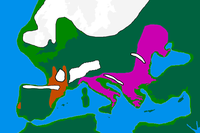
Photo from wikipedia
Geodiversity, defined as the natural range of geological, geomorphological, hydrological, and soil features, has been explored in a growing number of studies at different spatial scales. However, most research efforts… Click to show full abstract
Geodiversity, defined as the natural range of geological, geomorphological, hydrological, and soil features, has been explored in a growing number of studies at different spatial scales. However, most research efforts have been directed at analysing geodiversity at a fine-scale. Here, an estimation of the geodiversity of the European subcontinent is performed using six available high-resolution global data sets that describe the diversity of selected features of the abiotic environment. Six maps representing geomorphological, geological, hydrological, hydrogeological, soil, and topographical diversity are compiled using the methods of centroid analysis and kernel density estimation. The present contribution identifies areas with high values of most geodiversity variables which were not previously studied, nor are included in the network of international geoparks. The study also shows that, although remote sensing images and digital elevation models allow one to grasp a significant understanding of geodiversity on the continental scale, fine-resolution and process-oriented geological data sets are required to further enhance the quality of large-scale geodiversity assessments. To ensure interoperability between studies, a consensus is necessary regarding the analytical methods, classification rules, standardised indices and dictionaries. Without this, comparisons of geodiversity evaluations across different scales and between distant study areas remain difficult.
Journal Title: Resources
Year Published: 2023
Link to full text (if available)
Share on Social Media: Sign Up to like & get
recommendations!